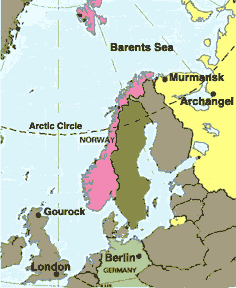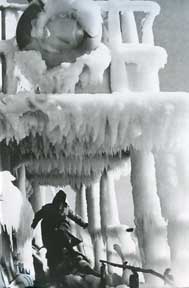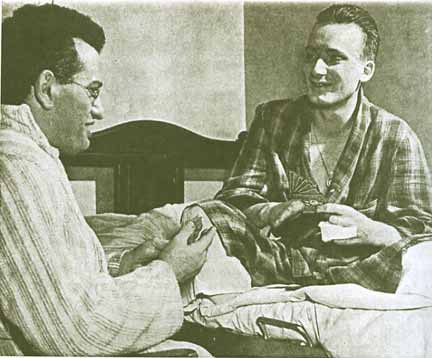August Wallenhaupt: Sole Survivor of SS Puerto Rican
SS Puerto Rican sailed to Murmansk in Convoy JW 51B. The convoy left Loch Ewe (near Gourock), Scotland on December 22, 1942 with heavy escort. They encountered two big storms, including one of Force 10 on the Beaufort scale (60 mph wind and waves 30 feet). Temperatures were so low, merchant ships reported thick slabs of ice on deck and even ice inside the bulkheads.
On December 31, 1942, the convoy escorts battled the German cruiser Admiral Hipper, armored ship Lutzow, and several destroyers. There were losses on both sides in what was later referred to as "The Battle of the Barents Sea." Lutzow fired her triple 11-inch guns at the convoy, with shell splinters hitting one merchant ship, American-owned (Panama-flag) Calobre. All 15 merchant ships arrived at Murmansk by January 5, 1943.
Map of the Arctic region Ice covered ship in the Arctic SS Puerto Rican was one of 30 merchant ships which left Murmansk in Convoy RA 53 on March 1, 1943. The convoy was scattered by storms, providing opportunities for U-Boats to attack. On March 5th, U-255 sank the American ship Executive and put a torpedo into No. 1 hold of Richard Bland. The torpedo did not explode. Later that day 12 Heinkel 111s came in for a shallow dive attack. The convoy threw up a terrific barrage which caused the planes to drop their bombs ineffectively.
On March 7, in heavy seas, many welds on Liberty ship SS J. L. M. Curry fractured; she foundered on the following day. A torpedo from U-586 found SS Richard Bland, splitting her in half. John H. B. Latrobe broke down and had to be towed to Iceland.
SS Puerto Rican straggled from the convoy during a gale. She was torpedoed by the Nazi submarine U-586 on March 9, 1943 about 100 miles northeast of Iceland (66 44 N, 10 41 W). Due to the severe weather and ice coating, 3 of the ship's 4 lifeboats were frozen and useless. When the 4th one hit the water, it's afterfall could not be released due to the ice, and the boat capsized. Eight men swam to a cork life raft and 6 of them later transferred to a larger raft.
Fireman August Wallenhaupt, 26 years old, was rescued 3 days later by the British HMS St. Elstan.
August Wallenhaupt plays cards with another seaman at the Marine Hospital on Staten Island. He was sole survivor of the sinking of the SS Puerto Rican
Torpedoed in the Arctic
The MAST Magazine, February 1945
August Wallenhaupt, the fellow pictured above with the smiling face and happy disposition, is the subject of one of the most fascinating stories that has been told about our Merchant Seamen in this war. He symbolizes the sufferings that hundreds of other seamen have had to endure during torpedoings and he also expresses the same courage and cheerfulness that are indicative of the seamen who have been within reaching distance of death.
Wallenhaupt is minus both legs, amputated at the knee; all fingers on his right hand and all but the index finger and thumb on his left hand. It is a miracle that he's alive today. Thanks, however, to his quick thinking and the sharp eyes of a lookout on a British destroyer, he is now out of the hospital and working in the office of a New York shipping company.
His story began on a stormy winter night in the Arctic Ocean, just 400 miles off the north coast of Iceland [100 miles in official records]. The ship was in convoy when she left a Russian port, but for two days the freighter had been alone, cut off from the convoy and the rest of the world by radio silence. The temperature was 30 degrees below zero and the water was a cool 21 degrees above zero --11 degrees below freezing. The entire ship was caked with ice.
Wallenhaupt was asleep in his quarters when the torpedo struck at 2200, but awoke instantly and immediately knew what had happened. He'd been torpedoed before. Wallenhaupt took time to dress warmly; he slipped on his rubber lifesaving suit (typical one shown at right), put on his life jacket over the suit and then put on a knee-length woolen seaman's coat with a hood to protect his head. This is the gear that saved his life.
He went out to his position at No. 4 boat and found other members of the crew trying to free the lifeboats from the ice. They rammed the boats with their shoulders but "it was like ramming your shoulder against the Empire State Building and expecting it to fall." The boat finally worked loose and was lowered into the water. Wallenhaupt noticed that the ship was sinking fast and figured that the lifeboat would be capsized because of the heavy ice on the falls, which would make it impossible to release the lines.
He threw himself out of the boat and tried to get clear of the sinking ship; he was only four feet from the side of the freighter when she went down but there was little suction and he remained afloat with little effort. A short distance away he saw one of the small doughnut rafts; it was impossible to swim but the heavy seas brought the raft to him and he climbed aboard. Wallenhaupt noticed that he'd lost his heavy fur-lined gloves and his hands were getting numb.
Seamen on a wooden life raft (SS Muskogee as photographed from U-Boat) Within ten minutes he'd pulled seven men aboard the tiny raft. Their hands were beginning to freeze and they tried to warm them by holding them over the automatic flare light on the raft. A large wooden raft floated by.
Wallenhaupt grabbed it and secured the two rafts together. Five of the men crawled over to the wooden raft. Two seamen, however, were sitting motionless in the doughnut raft. Wallenhaupt tried vainly to revive them.
He tried to join the men on the other raft and found that he had no control over his legs from the hips down. The other men helped him crawl aboard. They huddled together in the center of the raft and the heavy seas, breaking wildly over the tiny craft, covered them with a sheet of ice. One man had gone out of his mind and kept asking for help. All of them prayed. They tried to pray aloud but the water got in their mouths and the howling gale cut all other sounds.
The seas were 30 feet high and pitched the raft unmercifully. Shortly a huge wave washed one of the men overboard. Wallenhaupt shivered throughout the night, but the other men were numb with cold. At daybreak (11 AM) he noticed that another man was gone and soon he watched helplessly as a third seaman went over the side.
During the second night Wallenhaupt heard someone call out: "Aug, boy!"
The words were spoken softly, almost in a whisper, and Wallenhaupt knew it was the voice of his buddy on the ship -- a Navy gunner who slept in the bunk below him. [John Waldron Noonan, Armed Guard] At daybreak he saw that the man was gone and had called to him as he was washed over the side.
The other man on the raft was lying on his stomach, his head bare and iced over. He couldn't budge the man. He was frozen solidly to the bottom of the raft.
Wallenhaupt had now been on the raft 36 hours without food or drink. He quenched his thirst somewhat by bunching some snow together and lapping it with his tongue.
He lay on the pitching raft beside his frozen shipmate, drifting off into semi-consciousness as the seas washed over him. Shortly before daybreak on the third day he heard voices. He opened his eyes and looked around in the darkness but saw nothing. The voices, however, kept coming back to him throughout the day. He prayed aloud to drown out the sound.
It was nearly dark when the voices came back, stronger now. "Hello, there Hello, there!'' He said his prayers more loudly and buried his head into the hood.
Suddenly Wallenhaupt felt a violent bump against the side of the raft and when he looked up he could make out the side of a destroyer. The men on the deck of the warship broke out into cheers when they saw him move.
He was carried into the ship's sick bay where they gave him a hot cup of Bovril, a few sips of water, and a shot of morphine. His hands and feet were wrapped in ice-cold towels. He was safe now, but the real pain began. His hands were swollen to three times their normal size and were white with frost.
Wallenhaupt was taken ashore at an Iceland port and transferred to a U.S. transport. In the transport's sick bay they wrapped his legs in cotton and hoisted them on pulleys. He was kept alive by frequent injections of blood plasma and intravenous feeding. Morphine was injected at four-hour intervals.
He was taken to a hospital (which caught on fire while Wallenhaupt was there) and on the second day he came down with pneumonia and pleurisy. It was here that they amputated his legs and fingers. Then came a transfer to the States and he received his final treatment at the Staten Island Marine Hospital.
During his long stay at the hospital he learned to write, using the thumb and knuckle of the index finger. He hates sympathetic people and became a legend at the hospital with his perpetual good humor.
And since every story like this is bound to wind up with a happy ending, Wallenhaupt fell in love with one of the clerks in the hospital and now they're married.
SS Puerto Rican Merchant Marine Casualties
Last First Position Hometown Homestate Adaza Julian Manlangit Steward New York NY Andrew Leroy Nathaniel Chief Mate Brighton MA Barry Edgar Aloysius Wiper New York NY Brown Thomas Messman Brooklyn NY Bruneau Leozaire A.B. Putnam CO Caley Robert A.B. Cheshire ENGLAND DiSanza Joseph Andrew O.S. New York NY Donohoe John Oiler Jersey City NJ Fox Walter Russell A.B. New York NY Giammellaro Guiseppe Wiper New York NY Giboney Leonard Enoch A.B. Springfield MO Grant Edward Cook Brooklyn NY Greer Robert Lee Oiler Garland TX Hamilton George Marshall Jr. 3rd Mate Sewickley PA Hansen Aage Ernst Carpenter Copenhagen DENMARK Hildreth Ralph Bentley 3rd Mate Rochester NY Howard Robert Emery A.B. Seattle WA Hoz Joaquin Marion Oiler Brooklyn NY Jenkins Willis James 2nd Mate Baton Rouge LA Johnston John F/W Liverpool ENGLAND Jones William Chief Engineer Brooklyn NY Londema Gerrit Deck Engineer San Francisco CA Lowe Denton Scott Jr. O.S. Baltimore MD Lysaght George A.B. Providence RI MacMullin James Burnside Messman Philadelphia PA Meiran Norman William Frederick Purser San Francisco CA Muehle Erich Oswald Bosun Portland ME O'Brien Timothy Chief Cook New York NY Oliver Ralph Albert Master Philadelphia PA Reilly Gerard Francis A.B. Brooklyn NY Rios Rafael Angel Messman New York NY Robertson Louis Lloyd Messman New York NY Schechtman Joseph Leon Cook Dorchester MA Stallworth Walter Edward Radio Officer Columbus GA Torkelson Carrol O.S. Hudson SD Uriarte Enrique 2nd Engineer Bilbao SPAIN Vinson Elmer Ellsworth Jr. 3rd Engineer San Francisco CA Wallace Joseph Patrick F/W Kansas City MO Wheeler Wesley William 1st Engineer Halcyon CA
SS Puerto Rican U.S. Navy Armed Guard Casualties
Last First Rank Hometown Homestate Bortmas Raymond Frank S1c Girard OH Campbell David Herbert S2c El Cerrito CA Carr Charles Howard S1c Ripley OH Delisa John Anthony Jr. S1c Rosebank NY Edwards Manuel Alvin S1c Chicago IL Hoy Donald S. Ens. Shannon IL Hunter John Clore S1c Aurora IN Inboden George Guy S1c Martinsville IL Jameson Clarence Albert S1c Aurora IN Jansen Anton S1c Kaukauna WI Lukacovic Rudolph Albert S1c New York NY Mayer Lawrence Jacob S1c St. Paul MN Mirgain Emil Prosper S1c St. Louis MO Morgan George Howard S1c Koshkonong MO Noonan John Waldron S1c Loyal WI Osborne John Kermit S1c Nickelsville VA Perillioux Calvin Coolidge S1c Rita LA Pickens Doyce Newton S1c Dallas TX Pollock Millard Wayne S1c Lincoln IL Price Noah Aaron S1c Blountsville AL Price Edwin S1c London AR Price Lawrence S1c Chevrolet KY Radonski Walter S1c Akron OH Rehg Clarence Frederick S1c East St. Louis IL Smith John Franklin S1c Addison AL



